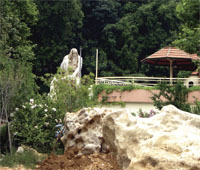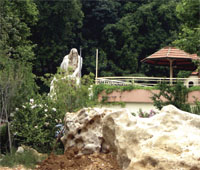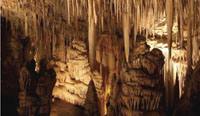
Jeita Grotto: An exhibition sculpted by water and time [Archives:2007/1057/Last Page]
June 7 2007
 |
 |
fatimafnfr@yahoo.com
There are many sites in Lebanon that tourists and visitors take pleasure visiting and which interest them to tour. Magharet Jeita is one of the most beautiful caverns in the Middle East and in Lebanon, in particular. They are green on the outside of the mountain and limestone inside the caverns. The outside of the mountain is green while inside the caverns is limestone.
The action of water Dripping, has created beneath the wooded hills of Mount Lebanon. A water carving exhibition exists under the hills of the forests on the mountains of Lebanon.
Visitors to Jeita grotto can witness the amazing views that many talk about, as curiosity causes them to discover the secrets of Jeita grotto's caves. It is a natural exhibition sculpted by water droplets and several million years. During the short visit presented via this article, readers may be able to see and imagine the grotto's exhibition.
The exciting two-hour tour begins with a short ride up the mountain in one of four Austrian cable cars.
The first part of the tour begins by going on foot to the upper galleries, while the second includes a boat ride through the lower galleries. There's also a film presentation depicting Jeita grotto's history in different languages.
The upper galleries
Visitors begin their tour in the upper gallery. The approach to these dry galleries through a 120-meter-long concrete tunnel does little to prepare visitors for the surprising world beyond. Formed several million years before the lower caverns, this section shows what the entire cave system was like before geological conditions displaced the subterranean river to its present level.
For 650 meters, visitors wind their way through the caverns' different levels, contemplating the flowing stone draperies and other formations. Perhaps the most dramatic sights are the yawning canyons and sinkholes, some dropping more than 100 meters.
Geologically, the caves provide a channel or escape route for the underground river, which is the principal source of Nar Al-Kalb, or Dog River.
The modern discovery of the underground river of Jeita dates to 1836 and is attributed to Rev. William Thomson, an American missionary who ventured some 50 meters into the cave.
The upper galleries were discovered in August 1958 by Lebanese speleologists and required at that a hazardous climb to 650 meters above the entrance of the underground river. The upper galleries opened in January 1969.
The lower galleries
Before entering the lower galleries is a huge statue of a seated elderly white man who seems sad, but no one knows why. Called the “Man of Time,” he appears to look at the visitors, observing them wisely and patiently.
The lower galleries take visitors from the caves to an underground world of severe beauty created over millions of years. The area contains the voice of water flowing and a sense of cold air.
The 600-meter boat trip on the subterranean lake is just a sample of the system, which has been explored for nearly 910 meters.
The first impression of this area is the sound of rushing water and a sensation of clean, cold air. However, the roar of a waterfall at the entrance gives way to profound silence as visitors glide deeper into the cave where an effective new lighting system illuminates expert rock climbers who marvel at the columns and sculptures fashioned by those great architects: water and time.
——
[archive-e:1057-v:15-y:2007-d:2007-06-07-p:lastpage]


